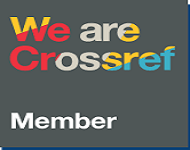Blended Learning Management in Madrasah Tsanawiyah During Covid-19 Pandemic
DOI:
https://doi.org/10.33394/jp.v10i1.6504Keywords:
Blended Learning, Management, Secondary School, Covid-19.Abstract
References
Adedoyin, O. B., & Soykan, E. (2020). Covid-19 pandemic and online learning: the challenges and opportunities. Interactive Learning Environments, 1–13. https://doi.org/10.1080/10494820.2020.1813180
Alqahtani, A. Y., & Rajkhan, A. A. (2020). E-learning critical success factors during the covid-19 pandemic: A comprehensive analysis of e-learning managerial perspectives. Education Sciences, 10(9), 1–16. https://doi.org/10.3390/EDUCSCI10090216
Alsarayreh, R. (2020). Using blended learning during COVID-19. Cypriot Journal of Educational Sciences, 15(6), 1544–1556. https://doi.org/10.18844/cjes.v15i6.5298
Chan, W. T. Y., & Leung, C. H. (2016). The Use of Social Media for Blended Learning in Tertiary Education. Universal Journal of Educational Research, 4(4), 771–778. https://doi.org/10.13189/ujer.2016.040414
Christensen, R., & Knezek, G. (2017). Readiness for integrating mobile learning in the classroom: Challenges, preferences and possibilities. Computers in Human Behavior, 76, 112–121. https://doi.org/10.1016/J.CHB.2017.07.014
Comas-Quinn, A. (2011). Learning to teach online or learning to become an online teacher: An exploration of teachers’ experiences in a blended learning course. ReCALL, 23(3), 218–232. https://doi.org/10.1017/S0958344011000152
Creswell, J. W., & Creswell, J. D. (2018). Research design: Qualitative, quantitative, and mixed methods approaches fifth edition. New York: SAGE Publications Inc.
Deja, M., Rak, D., & Bell, B. (2021). Digital transformation readiness: perspectives on academia and library outcomes in information literacy. Journal of Academic Librarianship, 47(5). https://doi.org/10.1016/J.ACALIB.2021.102403
Graham, C. R., Henrie, C. R., & Gibbons, A. S. (2013). Developing models and theory for blended learning research. Blended Learning: Research Perspectives, 2.
Güzer, B., & Caner, H. (2014). The Past, Present and Future of Blended Learning: An in Depth Analysis of Literature. Procedia - Social and Behavioral Sciences, 116, 4596–4603. https://doi.org/10.1016/J.SBSPRO.2014.01.992
Hayati, S., Armansah, Y., & Ismail, S. F. A. B. (2021). Teachers Experiences on Blended Learning: a Case Study of a Group of Secondary School Teachers in Malaysia and Indonesia. Jurnal Kependidikan: Jurnal Hasil Penelitian Dan Kajian Kepustakaan Di Bidang Pendidikan, Pengajaran Dan Pembelajaran, 7(4), 767–777. https://doi.org/10.33394/JK.V7I4.4102
Kaur, M. (2013). Blended learning-its challenges and future. Procedia-Social and Behavioral Sciences, 93, 612–617.
Kintu, M. J., Zhu, C., & Kagambe, E. (2017). Blended learning effectiveness: the relationship between student characteristics, design features and outcomes. International Journal of Educational Technology in Higher Education, 14(1), 1–20. https://doi.org/10.1186/S41239-017-0043-4/TABLES/6
Komsiyah, I. (2022). Students’ E-Learning Management at Home During Covid-19 Pandemic. AL-ISHLAH: Jurnal Pendidikan, 14(1), 343–350. https://doi.org/10.35445/ALISHLAH.V14I1.1965
L.Stufflebeam, D., & L.S.Coryn, C. (2014). Evaluation Theory, Models, and Applications (SecondEdit). United States of America: Jossey-Bass.
Lebedeva, M. (2020). Teaching Language in the Digital Era: Readiness and Expectations of Future Teachers. ARPHA Proceedings, 3, 1405. https://doi.org/10.3897/AP.2.E1405
Marković, M., Pavlović, D., & Mamutović, A. (2021). Students’ experiences and acceptance of emergency online learning due to COVID-19. Australasian Journal of Educational Technology, 37(5), 1–16. https://doi.org/10.14742/AJET.7138
Matukhin, D., & Zhitkova, E. (2015). Implementing Blended Learning Technology in Higher Professional Education. Procedia - Social and Behavioral Sciences, 206, 183–188. https://doi.org/10.1016/j.sbspro.2015.10.051
Miles, M., Huberman, A., & Saldaña, J. (2014). Sampling: Bounding the collection of data. In Qualitative Data Analysis: A methods Sourcebook. SAGE.
Nasution, A. K. P., Surbakti, A. H., Zakaria, R., Wahyuningsih, S. K., & Daulay, L. A. (2021). Face to Face Learning vs Blended Learning vs Online Learning (Student Perception of Learning). Journal of Physics: Conference Series, 1783(1). IOP Publishing Ltd. https://doi.org/10.1088/1742-6596/1783/1/012112
Ramakrisnan, P., Yahya, Y. B., Hasrol, M. N. H., & Aziz, A. A. (2012). Blended Learning: A Suitable Framework For E-Learning In Higher Education. Procedia - Social and Behavioral Sciences, 67, 513–526.
Sanoto, H., & Sanoto, H. (2021). Online Learning Management in The Covid-19 Pandemic Era. JETL (Journal of Education, Teaching and Learning), 6(1), 47–52. https://doi.org/10.26737/jetl.v6i1.2358
Setiawan, A. (2019). Conceptual of Blended Learning as Islamic Education Study Program Learning Reform Action in Digital Era 4.0. SYAMIL: Jurnal Pendidikan Agama Islam (Journal of Islamic Education), 7(2), 119–129. https://doi.org/10.21093/SY.V7I2.1827
Syaiful Romadhon, M., Rahmah, A., & Wirani, Y. (2019). Blended learning system using social media for college student: A case of tahsin education. Procedia Computer Science, 161, 160–167. Elsevier B.V. https://doi.org/10.1016/j.procs.2019.11.111
Yamani, H. A., Alharthi, A. D., & Smirani, L. K. (2022). Evaluation of Learning Management Systems. International Journal of Emerging Technologies in Learning (IJET), 17(07), 125–144. https://doi.org/10.3991/IJET.V17I07.28881
Zhao, S., & Song, J. (2021). What kind of support do teachers really need in a blended learning context? Australasian Journal of Educational Technology, 37(4), 116–129. https://doi.org/10.14742/AJET.6592
Downloads
Published
How to Cite
Issue
Section
Citation Check
License
License and Publishing Agreement
In submitting the manuscript to the journal, the authors certify that:
- They are authorized by their co-authors to enter into these arrangements.
- The work described has not been formally published before, except in the form of an abstract or as part of a published lecture, review, thesis, or overlay journal.
- That it is not under consideration for publication elsewhere,
- That its publication has been approved by all the author(s) and by the responsible authorities tacitly or explicitly of the institutes where the work has been carried out.
- They secure the right to reproduce any material that has already been published or copyrighted elsewhere.
- They agree to the following license and publishing agreement.
Copyright
Authors who publish with Jurnal Paedagogy agree to the following terms:
- Authors retain copyright and grant the journal right of first publication with the work simultaneously licensed under a Creative Commons Attribution License (CC BY-SA 4.0) that allows others to share the work with an acknowledgment of the work's authorship and initial publication in this journal.
- Authors are able to enter into separate, additional contractual arrangements for the non-exclusive distribution of the journal's published version of the work (e.g., post it to an institutional repository or publish it in a book), with an acknowledgment of its initial publication in this journal.
- Authors are permitted and encouraged to post their work online (e.g., in institutional repositories or on their website) prior to and during the submission process, as it can lead to productive exchanges, as well as earlier and greater citation of published work.
Licensing for Data Publication
-
Open Data Commons Attribution License, http://www.opendatacommons.org/licenses/by/1.0/ (default)






